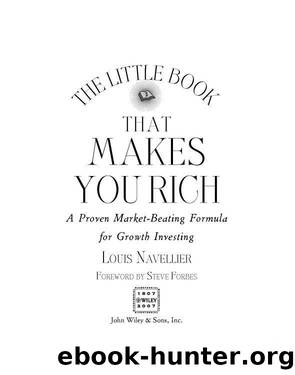The Little Book That Makes You Rich by Louis Navellier & Forbes Steve

Author:Louis Navellier & Forbes, Steve
Language: eng
Format: epub
Publisher: Wiley
Published: 2011-01-05T00:00:00+00:00
Chapter Eleven
Donât Be a Deviant
Deviance Is No More Appreciated in the Stock Market Than Anywhere Else in Life.
WHILE WEâVE COVERED the important topic of alpha and touched on risk versus reward, we need to delve into the concepts a bit deeper. I frequently hear a lot of talk by professional and individual investors about risk versus reward, but few of them offer a meaningful way to measure either. Some folks will point to various prices where they think that the risk for lower prices is higher or identify a price at which they think prices could rise, but this is poor guidance. As a numbers person, I knew that there had to be a better way to quantify and measure risk and reward, so I went looking for the answer and believe I have found it.
I do not want to sound like too much of a math geek, but a little explanation is necessary. Quantitative analysis is nothing more than applying mathematical theory to the movement of stock prices. We can chart stock movements and apply a series of statistical measurements to see how prices move in relationship to underlying market forces. Previously, I introduced you to the concepts of alpha and beta and how these measure each stockâs movement relative to the appropriate stock market benchmark.
Now Iâll introduce another character, a shady fellow who represents the excessive risk that needs to be avoided when owning growth stocks as measured by standard deviation or statistical variance. Standard deviation measures just how much a stock wiggles based on its trading range. When a stockâs price movement is too jerky and erraticâor volatileâitâs clearly a sign of bad things to come and needs to be avoided. Thatâs what standard deviation and my reward-to-risk measures help spot. In basic form, we divide a stockâs alpha (the return independent of the stock market that typically comes from buying pressure) by its standard deviation. We measure this over a 52-week period as we do with all our statistical measures. Any longer time frame than that is essentially too far back in the past and becomes less meaningful. For example, many quantitative analysts on Wall Street utilize five-year risk-and-reward measurements, but I think thatâs just too long. What does price movement from five years ago have to do with today? Thatâs too far back in the past and would lead to measuring movement in different economic and market environments with little impact on todayâs stock prices. My calculation gives us a number that I call the reward/risk ratio that determines my quantitative grade. Stocks with good reward/risk ratios tend to be lowerrisk stocks that are just plugging away, earning excess returns in a smooth consistent manner. These are the ones with the high quantitative grades that we want to own.
We recalculate these reward/risk measurements (e.g., alpha, beta, standard deviation, etc.) every weekend for every stock in my database. Thatâs almost 5,000 stocks. Any stock that trades 5,000 shares per day and has been trading for the
Download
This site does not store any files on its server. We only index and link to content provided by other sites. Please contact the content providers to delete copyright contents if any and email us, we'll remove relevant links or contents immediately.
| Analysis & Strategy | Bonds |
| Commodities | Derivatives |
| Futures | Introduction |
| Mutual Funds | Online Trading |
| Options | Portfolio Management |
| Real Estate | Stocks |
Pioneering Portfolio Management by David F. Swensen(5633)
Rich Dad Poor Dad by Robert T. Kiyosaki(5191)
How To Win Friends and Influence People by Dale Carnegie(3802)
The Money Culture by Michael Lewis(3312)
The Dhandho Investor by Mohnish Pabrai(3189)
The Wisdom of Finance by Mihir Desai(3108)
Liar's Poker by Michael Lewis(2834)
The Intelligent Investor by Benjamin Graham Jason Zweig(2607)
The ONE Thing by Gary Keller(2549)
Mastering Bitcoin: Programming the Open Blockchain by Andreas M. Antonopoulos(2532)
Investing For Dummies by Eric Tyson(2484)
How to Day Trade for a Living: Tools, Tactics, Money Management, Discipline and Trading Psychology by Andrew Aziz(2478)
How to Win Friends and Influence People by Dale Carnegie(2458)
Rich Dad Poor Dad: What The Rich Teach Their Kids About Money - That The Poor And Middle Class Do Not! by Robert T. Kiyosaki(2449)
Fooled by Randomness: The Hidden Role of Chance in Life and in the Markets by Nassim Nicholas Taleb(2437)
Zero Hour by Harry S. Dent Jr. & Andrew Pancholi(2258)
Market Wizards by Jack D. Schwager(2181)
Rich Dad's Guide to Investing by Robert T. Kiyosaki(2130)
How to Pay Zero Taxes, 2018 by Jeff A. Schnepper(2120)
